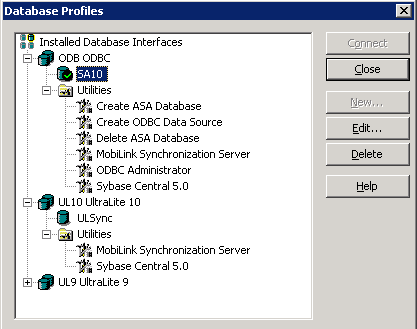The Database Profiles dialog box uses an easy-to-navigate tree control format to display your defined database profiles. You can create, edit, and delete database profiles from this dialog box.
When you run the PocketBuilder Setup program, the program creates a Vendors key under the PocketBuilder section of the system registry in HKEY_LOCAL_MACHINE\SOFTWARE, and adds the following registry string values: ODB for the ODBC interface, UL 10 for the UltraLite 10.x interface, and UL9 for the UltraLite 9.x interface.
Most PocketBuilder examples use a standalone database called asademo.db that is installed with Adaptive Server Anywhere 9. The PocketBuilder setup program also installs the ASADemo_10 database in the Code Examples\SA10DemoData directory. This database is a migrated version of asademo.db that you can use with SQL Anywhere 10. Table and column names in this database are different than the names in the SQL Anywhere 10 Demo database that installs with SQL Anywhere 10.
The Database Profiles dialog box in Figure 13-1 displays profiles for a SQL Anywhere database (SA10) and an UltraLite database (ULSync). The check mark on the SA10 profile indicates that it is currently connected. The figure also shows utilities you can use with these interfaces.
Figure 13-1: The Database Profiles dialog box
